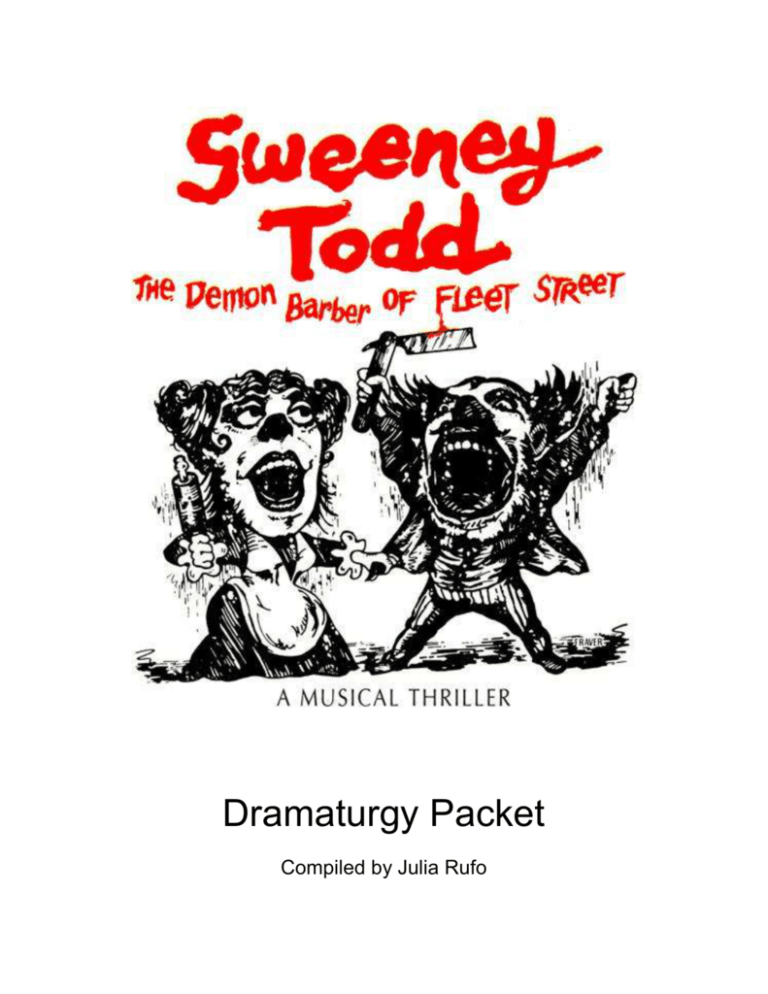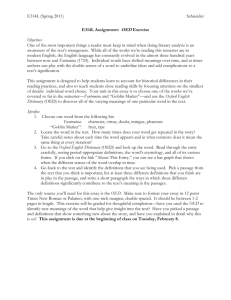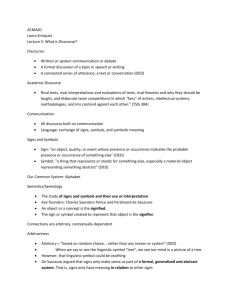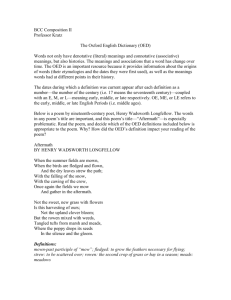Sweeney Todd Dramaturgy Packet - The Lyric Stage Company of
advertisement

Dramaturgy Packet Compiled by Julia Rufo Table of Contents Stephen Sondheim, the Art of the Musical ………………………………….. 2 http://www.theparisreview.org/interviews/1283/the-art-of-the-musicalstephen-sondheim True or False? ………………………………………………………………….. 3 www.pbs.org/kqed/demonbarber Newspaper, Novel, Blood ……………………………………………….…..... 4-5 www.pbs.org/kqed/demonbarber Trial and Punishment ………………………………………………………..... 6-7 www.pbs.org/kqed/demonbarber A String of Pearls ………………………………………………………………. 8 www.pbs.org/kqed/demonbarber 19th Century England Social Hierarchy …………………………………….… 9 http://www.hierarchystructure.com/19th-century-england-social-hierarchy/ Glossary of Terms ……………………………………………………………… 10-21 1 Excerpt from: Stephen Sondheim, The Art of the Musical INTERVIEWER Sweeney Todd was operatic, using leitmotifs, as opera does. Characters had themes and the themes assembled, disassembled, reassembled. You’ve said that you were influenced by, of all people, Bernard Herrmann. SONDHEIM True. When I was fifteen years old I saw a movie called Hangover Square, another epiphany in my life. It was a moody, romantic, gothic thriller starring Laird Cregar, about a composer in London in 1900 who was ahead of his time. And whenever he heard a high note he went crazy and ran around murdering people. It had an absolutely brilliant score by Bernard Herrmann, centered around a onemovement piano concerto. I wanted to pay homage to him with this show, because I had realized that in order to scare people, which is what Sweeney Todd is about, the only way you can do it, considering that the horrors out on the street are so much greater than anything you can do on the stage, is to keep music going all the time. That’s the principle of suspense sequences in movies, and Bernard Herrmann was a master in that field. So Sweeney Todd not only has a lot of singing, it has a lot of underscoring. It’s infused with music to keep the audience in a state of tension, to make them forget they’re in a theater, and to prevent them from separating themselves from the action. I based a lot of the score on a specific chord that Herrmann uses in almost all his film work and spun it out from that. That and the “Dies Irae,” which is one of my favorite tunes and is full of menace. 2 True or False? Sinister, depraved, monstrous ... true? Was Sweeney Todd a real person, or was he an invented bogeyman? The character has gone from a minor madman in a 19th-century newspaper serial to the melancholy murderer in Stephen Sondheim's beloved Broadway musical. His macabre career as a maniacal frightener of young and old has spanned two centuries, but is it grounded in fact? For generations, scholars and historians have debated the existence of the Demon Barber. Sweeney Todd's first known appearance in print was in an 1846 "penny dreadful," a type of horror tale of the era published in serial form, The People's Periodical. The razor-wielding barber who turned his victims into meat pies was a secondary character in the short story The String of Pearls: A Romance, written by Thomas Prest. With its bloody killing spree, ghoulish villain and macabre recipe for disposing the evidence, "The String of Pearls" was perfect fodder for the Victorian imagination. George Dibdin Pitt, a hack playwright of the time who commonly purloined other people's ideas, immediately dramatized Prest's story for the stage. Retitling it The String of Pearls: The Fiend of Fleet Street, Pitt advertised his production one year later as "Founded on Fact." The play, set in the reign of George II (the late 18th century), debuted on March 1, 1847, at the Hoxton Theatre, a London "bloodbath" - a theater specializing in sensational melodramas. Ever since, speculation has raged about whether the Demon Barber was man or myth. There are no clear answers. No public records substantiate the existence of a London barber named Todd in the late 18th century or, for that matter, of a barber shop located on Fleet Street. But there were certainly enough bits and pieces of real-life horror floating around at the time, reported in "The Old Bailey" section of the London Times, as well as other daily newspapers. The public had an enormous appetite for all things gruesome and devoured local news accounts of wicked deeds and nefarious crimes. And because news commonly traveled by word of mouth (much of the population was still illiterate), stories of shocking criminal exploits passed from person to person (with probable embellishment along the way) and were asserted to be "true fact." To add to the confusion, many penny dreadfuls were fictionalized accounts of real crimes. And Thomas Prest, the writer who first set down Sweeney Todd's name in print, was known to hunt regularly through newspapers for his story ideas. 3 Newspaper, Novel, Blood Fleet Street, the supposed home of the dreaded barber, has long been associated with newspapers, booksellers and the printing industry. Most English people could neither read nor write at the beginning of the 18th century, though literacy grew as printed materials became more readily available. The first newspaper, or "one-sheet," to be published in London was the Daily Courant, which ran from 1702 to 1735. Mass publications like the Courant found an increasing audience, and London had upwards of eight daily newspapers in publication at the century's close. Books in the 1700s were terribly expensive, being printed and bound by hand, and sold in very limited editions. Few people could afford them, so they were available to the mass market only in serial form or in cheap pirated copies. Episodic stories, which eventually evolved into the English novel, were distributed to the public through newspapers and other printed entertainments. The novel as we know it actually materialized between 1715 and 1750, and was largely the achievement of four professional writers, all of them Londoners. These pioneering works include Daniel Defoe's Robinson Crusoe and Moll Flanders, Samuel Richardson's Pamela, Tobias Smollett's Humphrey Clinker and Roderick Random, and Tom Jones by Henry Fielding (the very same law enforcement pioneer who formed the Bow Street Runners). This period witnessed a rising interest in the natural sciences. Rather than relying on theories passed down through generations, barber-surgeons began dissecting bodies; botanists went out into fields to collect samples; geologists dug up fossils with their own hands. The more bizarre the discovery, the more the public's curiosity was aroused. So-called Books of Wonder became highly popular, chronicling "strange but true" phenomena such as dwarves, hermaphrodites, and other "memorable accidents and unheard-of transactions." A generation later, when readers were illuminating their books with flickering oil lamps that cast spooky shadows across their heavy Victorian rooms, horror tales became an immensely popular form of entertainment. Monsters, vampires, ladies in distress, sensational criminals and unspeakable acts of terror populated a new type of publication geared toward the masses - the penny dreadful. Also known as bloods and shilling shockers, penny dreadfuls were inexpensive novels published in serial form, usually eight pages at a time. Distributed at newsstands and dry goods stores, they were cheaply made so they could be sold for a penny per copy, hence their name. Penny dreadfuls were gory and violent, with graphic, lurid illustrations. Henry James' The Turn of the Screw was a penny dreadful serialized in 1888. Michael Anglo notes in his book Penny Dreadfuls and Other Victorian Horrors, "There were dark dungeons and torture chambers, sepulchral vaults, secret panels and stairways, cobwebs, and bats. The eerie atmosphere, reeking of the charnel house, was designed to make the hackles rise, the flesh creep, and the blood curdle - no easy task in the days when people were inured to the gruesome and the macabre by the frequent 4 public hangings and floggings, and the sight of criminals' decomposing corpses dangling on gibbets."(1) Like tabloid newspapers today, penny dreadfuls were churned out at a furious pace. Publishers unscrupulously culled their ideas from whatever sources they could find - popular fiction, legendary tales, newspaper accounts of petty crimes - and embellished these stories with as many gruesome details as possible. The sinister Sweeney Todd made his print debut in issue number 7 of The People's Periodical and Family Library, dated November 21, 1846. He appeared as the villain, an evil, murderous barber, in a serial written by Thomas Prest with the improbable title "The String of Pearls; or the Sailor's Gift. A Romance of Peculiar Interest." Todd was only a secondary character in this story, but his activities earned him the moniker of "the Demon Barber of Fleet Street" right from the first publication. 5 Trial and Punishment The workings of a criminal court in the 18th century were quite different from what we expect today. For one thing, the magistrate often acted more as public prosecutor and chief detective than impartial judge. Between 1750 and 1850 most criminal cases were characterized by face-to-face confrontation between the prosecutor and the accused. Defense counsel rarely appeared. The assumption was that the accused had no need of counsel, since the burden of proof was on the prosecution and the accused was a greater expert on the truth. When clarification was needed, the trial judge was expected to assist the accused with advice. Prisoners were not allowed to see the evidence against them before trial, and, once in the courtroom, were not allowed to testify (since they could not be trusted to uphold an oath). They were also not entitled to sum up their defense for the jury, though the prosecution was given the opportunity to make a final statement. Before trial, the prisoner was expected to submit a written defense that was to be read aloud in court. This was a grave disadvantage for the poor and the ignorant, who frequently could neither read nor write. Some prisoners "stood mute," refusing to answer "guilty" or "not guilty" to the charges against them. In such cases, they would be stretched out on the ground and pressed with crushing lead weights until they spoke. Sometimes they died in the process. Defense counsel, according to evidence of the Old Bailey Sessions Papers, began to make very rare appearances in criminal trials during the 1730s, but for the 18th century and the early part of the 19th century their role was not strictly defined. It was not until the late 19th century that cross-examination was consistently practiced, with objections to leading questions - but there was still a willingness to allow so-called expert witnesses to give decisive opinions on the whole question of guilt. Up until 1774, prisoners who were discharged or found not guilty through trial usually had to pay back the expenses related to their imprisonment - these were known as "jailor's fees." Because many could not afford to pay, they found themselves re-imprisoned, this time as debtors. It was a vicious circle. Punishment In an age virtually without police, the machinery of law was uncompromising and brutal. In total, 240 offenses were punishable by death, and hanging was prescribed for accessories as well. Punishments ranged from standing in the pillory to branding and whipping to burning (for particularly shameful crimes, like treason). A number of 18th century theorists believed hanging was not punishment enough for felons and proposed "breaking on the wheel" instead. In 1752, a law was passed that required "some further Terror and peculiar mark of Infamy be added to the Punishment of Death" for murder. The 6 convicted murderer was to be kept on bread and water in a special cell, and after execution, his body was to hang in chains before the public, then go to the surgeons for dissection. "Dr. Samuel Johnson was one who saw that capital punishment satisfied a sinister human craving for power over others' lives, but did not really deter crime. Undiscriminating severity simply made criminals more cunning and more desperate, and confused small crimes with great ones." -Clive Elmsley, Crime and Society in Society in England 1750-1900 (11) Juries were generally loath to convict people for property crimes, since the penalty of death seemed disturbingly harsh. In fact, many victims declined to pursue matters through the legal system out of a sheer unwillingness to see the perpetrators hanged for their offense. However, imprisonment was not considered a reasonable alternative to capital punishment, since it placed young criminals into contact with older, hard-bitten ones, encouraging partnerships. The ingenious idea of transportation became an alternative punishment beginning around 1718. Criminals were deported to the remote colonies of Maryland and Virginia on the American shore and, later in the century, were sent off to settle New South Wales, Australia. 7 A String of Pearls For almost two centuries, the enduring legend of maniacal barber Sweeney Todd and his savory human pies has inspired terror in the hearts and minds of the public, whether through the printed page or the theatrical stage. 1825 - The French story of a murderous barber appears in Tell-Tale Magazine under the title "A Terrible Story of the Rue de la Harpe." 1846 - Thomas Peckett Prest serializes the story, retitled The String of Pearls. It is published in one of London's penny dreadful newspapers. (The title came from a necklace that Sweeney steals from one of his victims.) Weekly installments of the barber's homicidal exploits become immensely popular. 1847 - The String of Pearls is dramatized by George Dibdin-Pitt. His melodrama, subtitled "The Fiend of Fleet Street," is set in London during the "Reign of George II," or the second half of the 18th century. The play opens at the Britannia Theatre, where audiences demand bloodcurdling entertainments, and is advertised as being "Founded on Fact." 1848 - The enormous success of Dibdin-Pitt's play spawns dozens of imitations. In some, the hero is a dog whose master has met his end via Sweeney's blade. The faithful dog haunts the barber's doorstep and eventually leads authorities to the fiend. These bloody melodramas were continuously produced in and around London throughout the remainder of the 19th century. 1936 - The Demon Barber of Fleet Street, directed by George King, becomes the first film version of the story. Todd Slaughter, the film's star, makes a career out of portraying Sweeney Todd on stages around the world. 1959 - The Royal Ballet Company produces a ballet version, with music by Malcolm Arnold and choreography by John Cranko. 1973 - Sweeney Todd, The Demon Barber of Fleet Street by Christopher Bond opens at the Theatre Royal Stratford East. This version is seen by composer/lyricist Stephen Sondheim, who recruits book writer Hugh Wheeler to collaborate with him on a musical treatment of Bond's play. 1979 - Sondheim and Wheeler's Sweeney Todd: The Demon Barber of Fleet Street opens at Broadway's Uris Theatre in a production directed by Harold Prince and starring Angela Lansbury and Len Cariou. The recipient of eight Tony Awards, Sweeney Todd is instantly recognized as a landmark in musical theater inspiring productions in both theater and opera companies around the world. 2001 - Sweeney Todd: The Demon Barber of Fleet Street is performed in concert with the San Francisco Symphony. The performance, starring George Hearn and Patti LuPone (as Sweeney Todd and Mrs. Lovett), is filmed by Ellen M. Krass Productions. The resulting television program premieres on PBS October 31, 2001. 8 19th Century England Social Hierarchy 9 Glossary of Terms Page 1 Line Environs Definition pl. The areas surrounding a place (freq. an urban area); one's surroundings. - OED 1 Fleet Street. n. a street in London devoted largely to the production and publication of daily newspapers and periodical journals; hence allusively, the national newspapers generally, the journalistic press, journalism. - OED http://charlesdickenspage.com/images/fleet_street_then_and_now.jpg 2 A lavabo and a fancy n. The basin used for the washing. chair. - OED 2 A mug of suds and a leather strop. n. A strip of leather (or of a special textile), or a strip of wood covered with leather or other suitable material, used for sharpening a razor; a razor-strop. - OED 4 Todd is described as “saturnine.” adj. Hence (in later use without allusion to the primary sense), sluggish, cold, and gloomy in temperament. - OED 5 Alms n. Charitable relief given to the poor or needy, usu. (now only) in the form of material gifts, typically of money or food; (in later use esp.) the goods given in this way. - OED 10 8 Meat pies in England. “In medieval England, they were called pies, and instead of being predominantly sweet, they were most often filled with meat — beef, lamb, wild duck, magpie pigeon — spiced with pepper, currants or dates.” http://content.time.com/time/nation/article/0,8599,1862315,00.html http://static.guim.co.uk/sys images/Guardian/Pix/pictu res/2009/10/2/125449823 0700/Meat-pie-001.jpg 12 Beadle n. One who delivers the message or executes the mandates of an authority. - OED 12 13 14 Every day they’d nudge and they’d wheedle. v. To entice or persuade by soft flattering words; to gain over or take in by coaxing or cajolery. So they merely shipped the poor blighter off south they did. n. slang. A contemptible or unpleasant person; often merely as an extravagant substitute for ‘fellow’. The dumb show vanishes. adj. Destitute of the faculty of speech. deaf and dumb. (i.e. silent) -OED - OED - OED 15 Arsenic. n. Poison. - OED 15 Apothecary. n. One who kept a store or shop of non-perishable commodities, spices, drugs, comfits, preserves, etc. - OED 11 16 Razor case. http://www.freedm us.demon.co.uk/R azor4b.jpg 16 I could have got five, maybe ten quid for ‘em, any day. A pound sterling (£), in British slang, possibly derived from the Royal mint at Quidhampton, Wiltshire, England, but more likely from the Latin phrase ' Quid pro quo' (This for that) meaning an exchange of goods. http://www.reference.com/browse/quid?s=t 16 18 My, them handles is chased silver, ain’t they? adj. Ornamented with embossed work, engraved in relief. - OED Green Finch http://www.birdinginmalt a.com/species_greenfin ch.html 18 Linnet Bird http://www.fotoplatform a.pl/fotografia/en/5971/ 12 18 Nightengale http://cambsbirdclub.blogsp ot.com/2010/04/nightingale _26.html 18 Blackbird http://www.telegraph.c o.uk/earth/wildlife/857 9702/Starvingblackbirds-turncannibal-due-to-dryweather.html 19 Ringdove http://www.backyardbirdcam.co m/gallery/rtdo.htm 19 Robinet http://birding.about.com/od/birdp rofiles/p/europeanrobin.htm 13 19 Lark http://www.photodictionary.com/phr ase/4863/malabarcrested-lark.html 23 Fondling the truncheon. A truncheon or baton... is essentially a stick of less than arms-length, usually made of wood, plastic, or metal,and carried by law enforcement, corrections, security, and (to a less common degree) military personnel for less-lethal selfdefense, as well as control and to disperse combative and non-compliant subjects. A truncheon may be used to strike, jab, block,and aid in the application of armlocks. http://www.reference.com/browse/wiki/Baton_(law_enforcement) 24 How sweet you look in that light muslin gown. n. Any of various lightweight cotton fabrics in a plain weave. Also: a piece of such fabric; a dress or other article of clothing made of muslin. - OED 24 St. Dunstan’s Marketplace Dunstan served as an important minister of state to several English kings. He was the most popular saint in England for nearly two centuries, having gained fame for the many stories of his greatness. Adding to Dunstan's myth was his legendary cunning in dealing with the Devil...He functions as the patron saint of goldsmiths, as he worked as a blacksmith, painter, and jeweller. http://www.reference.com/browse/wiki/Dunstan 14 24 A hand drawn caravan, painted like a Sicilian donkey cart... Hand-drawn caravan: http://www.wildhorseboo ks.com/Plans/Thompson /Bow_top.JPG Sicilian donkey cart: http://almostitalian.com/i mages/sicilian-cart-anddonkey.jpg 24 Pirelli’s Miracle Elixir. n. A sovereign remedy for disease. Hence adopted as a name for quack medicines, as Daffy's elixir, etc. - OED 26 Doffs his cape dramatically. v. To put off or take off from the body (clothing, or anything worn or borne); to take off or ‘raise’ (the head-gear) by way of a salutation or token of respect. - OED 28 See that chap with hair like Shelley’s? Percy Bysshe Shelley was an English romantic poet, born 1792 died 1822 who was also known for his thick and wavy hair. http://www.reference.com/brows e/shelley?s=t 15 33 ...a sinister-looking tooth extractor. https://c1.staticflickr.com/7/ 6197/6045720540_785b36 8865_z.jpg 42 Sweeney Todd’s Tonsorial Parlor. adj. Of or pertaining to a barber or his work; often used humorously, as ‘a tonsorial artist’. - OED 42 43 44 ...my uncle’s cousin and arrived from Birmingham... Mea culpa, mea culpa Mea maxima culpa Mea maxima maxima culpa He picks up a scourge from the table. A town in Warwickshire, in England. - OED My fault, my fault I have failed My biggest fault - Google Translate (Latin) n. A whip, lash. Now only rhetorical, with reference to the torturing of human beings, or to ascetic discipline. - OED 45 I’ll wed you on the morrow. n. The following day; the day subsequent to any specified day; tomorrow, the day immediately following today. - OED 47 At the foot of the outside staircase is a brand-new barbers pole. http://www.zandkantiques.com/a ntiques/Trade_Sign_19th_Centu ry_American_Painted_Antique_ Barber_Pole_7.jpg 16 48 ...after his leg gave out from the dropsy. n. A morbid condition characterized by the accumulation of watery fluid in the serous cavities or the connective tissue of the body. - OED 50 Gillyflowers, maybe... http://thecranberrychronicle.b logspot.com/2010/05/giddyover-gillyflowers.html 50 ...’Stead of daisies. http://www.hdwallpapersare na.com/wpcontent/uploads/2014/04/dai sies-summer-1920x12003.jpg 51 Now I must hurry for surely the Judge is off to the Old Bailey. The Old Bailey is the Central Criminal Court in England, commonly known as the Old Bailey , is a court building in central London, one of a number housing the Crown Court. http://www.reference.com/browse/Old+Bailey?s=t 54 56 56 Benjamin Barker, later transported to Botany Bay for life. Botany Bay, is an inlet, New South Wales, SE Australia, just S of Sydney. Those who thought him a simple clod. n. A blockhead, clodpate; a clodhopper. http://www.reference.com/browse/Botany+bay?s=t - OED n. Full armour; a complete suit of armour. Freq. with Judge Turpin in fully panoply of wig, robe, connotations of brightness and splendour. etc. - OED 17 58 That’s what I’ll do, I’ll get some lye. n. The limpid acrid fluid which runs from a blister or the like; the ‘water’ which collects in the body in dropsy. - OED 60 St. Dunstan’s, noon. n. The church of St. Dunstan. - OED 62 Given their genteel proclivities... n. An inclination toward something (esp. something considered morally wrong); a predisposition, a tendency. - OED 62 64 64 Perhaps at times I am a little overyhasty with my morning ablutions... n. The act or process of washing clean. - OED I’m a silly little ninnynoodle Ninny: n. A simpleton; a fool. I’ll take my reticule. n. A small handbag, typically made of a soft fabric, tied with a drawstring, and decorated with embroidery or beading. - OED - OED 69 ...he’s half seas over Half-drunk. already with the gin. - OED 70 ...while I get a new bottle from the larder. n. A room or closet in which meat and other provisions are stored. So fetch the pomade... n. Originally: a scented grease or ointment applied to the skin as a perfume, cosmetic, or salve. In later use : a scented ointment or oil used to dress the hair. 70 - OED - OED 18 70 ...and pumice stone. n. As a mass noun: a very light, porous, grey or palecoloured volcanic rock, proverbial for its dryness and often used as an abrasive in cleaning, polishing, removing dead skin, etc., or as an absorbent for moisture. - OED 75 “The fat’s in the fire, for sure!” A course of action with inevitable bad consequences has begun; there's trouble ahead. http://dictionary.reference.com/browse/fat+is+in+the+fire,+the 78 82 Later I can fob him off with some story easy. v. To cheat, deceive, delude, trick, impose upon. ...but not as bland as curate, either. n. A clergyman who has the spiritual charge of a parish (or parochial district); the parson of a parish. - OED - OED 83 More like vicar. n. One who takes the place of, or acts instead of, another; a substitute, representative, or proxy. Chiefly Christian Church. Pronunciation: /ˈvɪkə(r)/ - OED 86 It’s fop, finest in the shop. n. One who is foolishly attentive to and vain of his appearance, dress, or manners; a dandy, an exquisite. - OED 88 At that delicate, luscious ambrosial smell. adj. orig. in the Greek mythology: Belonging to or worthy of the gods, as their food, anointing oil, locks, raiment, sandals, etc. - OED 95 Oh well, got her comeuppance. n. A punishment or fate that someone deserves. http://www.oxforddictionaries.com/ 19 96 That glaze, those crimps... n. to pinch and press down the edges of (a pie crust),especially to seal together the top and bottom layers of pastry. http://dictionary.reference.com/ 101 101 ...noxious plume of black. adj. Harmful, poisonous, injurious; unwholesome. - OED n. A straw bed or mattress; an inferior bed or sleeping ...carrying a meager straw pallet, her bed. place. - OED 101 106 107 Every night at the vespers bell. n. a bell rung at evening. That’s the sort of scalawag that gets this neighborhood into disrepute. n. A disreputable fellow; a good-for-nothing; a scapegrace, blackguard; in Trade Union slang, a man who will not work. Sitting at a harmonium. n. A keyboard instrument, the tones of which are produced by free metal ‘reeds’, tongues, or ‘vibrators’, actuated by a current of air from bellows, usually worked by treadles; a kind of reed-organ. http://dictionary.reference.com/ - OED - OED Strictly distinguished from the American organ by the fact that the air is driven outwards through the reed-pipes, whereas in the latter it is sucked inwards; but the name is sometimes extended to include the American organ. http://tardis.dl.ac.uk/FreeReed/organ _book/node17.html 20 109 ...Aunt Nettie used to take me to the seaside August Bank Holiday... A holiday on the last Monday in August. “The curious history of our official bank holidays begins in 1871, when they were first recognised in an Act of Parliament authored by Sir John Lubbock. He was a banker who, it is said, was so keen on cricket he chose dates when village matches were played in his home county.” - BBC News - The Politics of Bank Holidays 109 We’ll have our kippered herring... n. this method of curing fish. - OED http://www.eatwithmagnus.com/ 2010/12/30/kippered-herringsfrom-cley-smokehouse/ 126 But if three bells ring in the Tower of Bray. The 'Bray' in the title is most probably the village of Bray, Berkshire, on the south bank of the Thames immediately east of Maidenhead, and the church of St Michael, Bray was the living which the vicar was so keen to hang onto. The Vicar of Bray: The song starts with the Restoration of the monarchy and has the main character changing his views with every change of monarch through to the Hanoverian George I. http://www.britainexpress.com/attraction-articles.htm?article=29 132 Anthony stops briefly to reconnoiter nervously. v. To inspect, examine, or survey (a district or tract of ground) in order to discover the presence or position of an enemy, or to find out the resources or military features of the country. - OED 140 Quickly, sir, a splash of bay rum! n. an aromatic liquid, used by perfumers, obtained by distilling rum in which bay-leaves have been steeped. - OED 21








